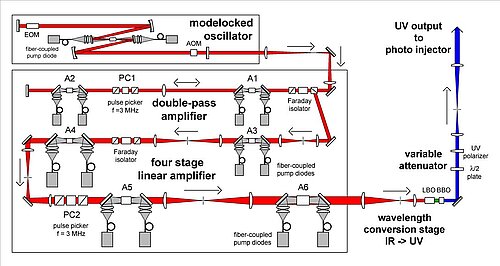4.1 Implementation of Lasers and Measuring Techniques
Project coordinators: I. Will , F. Furch , M. van Moerbeck-BockDrive laser of the FLASH FEL at DESY Hamburg
The MBI has been responsible for the development of the laser driving the photo injector (RF gun) of the FLASH FEL since 1997. From that time on we have installed four generations of lasers at the FLASH facility and its predecessors. The laser produces bursts of up 800 (2400) pulses with a repetition rate of 10 Hz. The repetition rate within the individual pulses within the burst amounts to 1 MHz (3 MHz).
The current version //is completely diode-pumped and// contains the following main building blocks:
- the laser oscillator,
- a chain of six amplifier stages A1 to A6,
- two Pockels cells PC1 and PC2 that are integrated into the amplifier chain,
- the wavelength converter,
- a variable attenuator,
- optics to image the ultraviolet pulses
The oscillator operates in a burst mode and contains several active mode-lockers in such a manner in its cavity that pulses with 18 ps duration (FWHM) at a repetition rate of 54 MHz. These mode lockers are driven by RF signals of appropriate frequencies that are derived from the master clock oscillator of the linac. In order to exactly match the modulation frequency of the amplitude modulators (AOM) the resonator length is constantly adjusted by a Piezo actuator control computer in such a manner that the oscillator produces pulse trains with an undisturbed, flat portion of the pulse train envelope of > 2 ms duration In addition to the stable generation of picosecond pulses, the active mode locking technique also ensures a reliable synchronization between the produced laser pulses and the accelerating RF field of the photo injector.
An amplifier chain raises the energy of the picosecond pulses of Gaussian shape by more than four orders of magnitude. It includes four spatial filters, two Pockels cells with their drivers, two Faraday isolators and six gain modules. The first two gain modules are used in double-pass. Thus it takes in total eight passes through the individual amplifier modules to increase the energy of the weak input laser pulses to their final output energy.
In order to preserve a stable beam profile during the pulse trains the last four amplifier stages have been connected by relay-imaging telescopes. This way the laser beam profile of each amplifier stage is successively enlarged and imaged into the following one. This aids in reducing the undesirable effect of thermally induced perturbation of the refraction index in the laser rods on the beam profile (thermal lensing). Due to the presence of pinholes in the foci of the lenses the telescopes, in addition, act as spatial filters and improve the quality of the amplified laser beam significantly.
The final de-magnifying telescopes adapts the power density of the infrared (IR) pulses from the laser system with 1047 nm wavelength to the optimum level for efficient conversion to ultraviolet (UV) pulses a wavelength of 262 nm by the arrangement of an 8 mm long LBO, followed in close proximity by a 6 mm long BBO. The first crystals generates the second harmonics of the infrared laser radiation, the second one transfers this radiation to the to ultraviolet (UV) pulses. A maximum efficiency of 16% is obtained.
